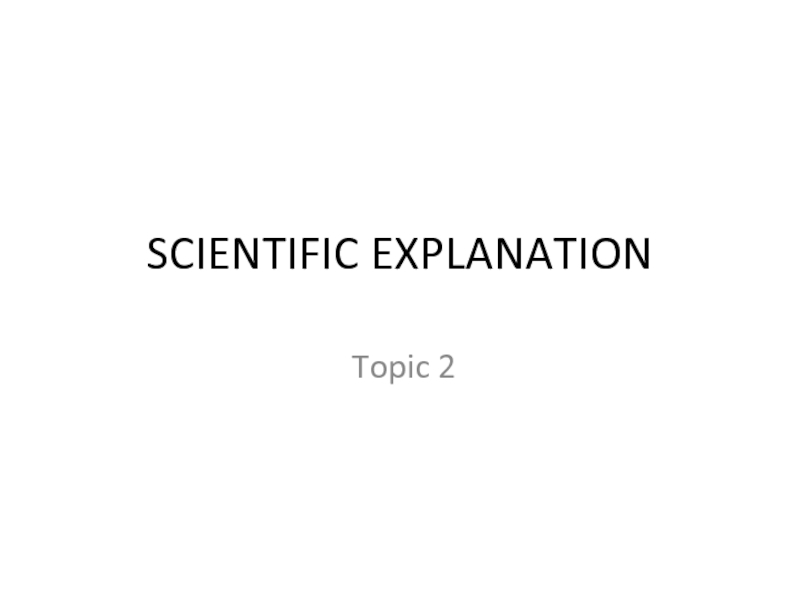- Главная
- Разное
- Дизайн
- Бизнес и предпринимательство
- Аналитика
- Образование
- Развлечения
- Красота и здоровье
- Финансы
- Государство
- Путешествия
- Спорт
- Недвижимость
- Армия
- Графика
- Культурология
- Еда и кулинария
- Лингвистика
- Английский язык
- Астрономия
- Алгебра
- Биология
- География
- Детские презентации
- Информатика
- История
- Литература
- Маркетинг
- Математика
- Медицина
- Менеджмент
- Музыка
- МХК
- Немецкий язык
- ОБЖ
- Обществознание
- Окружающий мир
- Педагогика
- Русский язык
- Технология
- Физика
- Философия
- Химия
- Шаблоны, картинки для презентаций
- Экология
- Экономика
- Юриспруденция
Scientific explanation презентация
Содержание
- 1. Scientific explanation
- 2. What questions can science answer? The
- 3. A new approach in the philosophy
- 4. It has sometimes been asserted that explanation
- 5. the deductive-nomological (D-N) model The deductive-nomological model (DN
- 6. four conditions of adequacy for D-N explanations
- 7. 3. The explanans must have empirical content;
- 8. A law and a law-statement A
- 9. All gases, kept in closed containers of
- 10. (vii) No enriched uranium sphere has a
Слайд 2
What questions can science answer?
The supposition—common before the rise of modern
science—that the universe is a cozy little place, created for our benefit, with humans at its center, is an anthropomorphic conception.
Слайд 3
A new approach in the philosophy of science
Karl R. Popper (1935),
Carl G. Hempel (1948), R. B. Braithwaite (1953), and Ernest Nagel (1961) published important works in which they maintained that there are such things as legitimate scientific explanations, and that such explanations can be provided without going beyond the bounds of empirical science.
Слайд 4It has sometimes been asserted that explanation consists in reducing the
mysterious or unfamiliar to that which is familiar.
Appealing as the notion of reduction of the unfamiliar to the familiar may be, it is not a satisfactory characterization of scientific explanation.
Appealing as the notion of reduction of the unfamiliar to the familiar may be, it is not a satisfactory characterization of scientific explanation.
Слайд 5the deductive-nomological (D-N) model
The deductive-nomological model (DN model), also known as Hempel's model,
the Hempel–Oppenheim model, the Popper–Hempel model, or the covering law model, is a formal view of scientifically answering questions asking, "Why...?". The DN model poses scientific explanation as a deductive structure—that is, one where truth of its premises entails truth of its conclusion—hinged on accurate prediction or postdiction of the phenomenon to be explained.
Слайд 6four conditions of adequacy for D-N explanations
1. The explanandum must be
a logical consequence of the explanans; that is, the explanation must be a valid deductive argument.
2. The explanans must contain at least one general law, and it must actually be required for the derivation of the explanandum; in other words, if the law or laws were deleted, without adding any new premises, the argument would no longer be valid.
2. The explanans must contain at least one general law, and it must actually be required for the derivation of the explanandum; in other words, if the law or laws were deleted, without adding any new premises, the argument would no longer be valid.
Слайд 73. The explanans must have empirical content; it must be capable,
at least in principle, of test by experiment or observation.
4. The sentences constituting the explanans must be true.
4. The sentences constituting the explanans must be true.
Слайд 8A law and a law-statement
A law is a regularity that
holds throughout the universe, at all places and all times.
A law-statement is simply a statement to the effect that such a regularity exists.
How to prove a law-statement?
A law-statement is simply a statement to the effect that such a regularity exists.
How to prove a law-statement?
Слайд 9All gases, kept in closed containers of fixed size, exert greater
pressure when heated.
In all closed systems the quantity of energy remains constant.
No signals travel faster than light.
Contrast these with the following:
(iv) All of the apples in my refrigerator are yellow.
All Apache basketry is made by women.
(vi) No golden spheres have masses greater than 100,000 kilograms.
In all closed systems the quantity of energy remains constant.
No signals travel faster than light.
Contrast these with the following:
(iv) All of the apples in my refrigerator are yellow.
All Apache basketry is made by women.
(vi) No golden spheres have masses greater than 100,000 kilograms.
Слайд 10(vii) No enriched uranium sphere has a mass greater than 100,000
kilograms.
Philosophers have often claimed that we can distinguish true generalizations that are lawful from those that are accidental. Even if we grant the truth of, we must conclude that it is an accidental generalization. Moreover, they have maintained that among universal generalizations, regardless of truth, it is possible to distinguish lawlike generalizations from those that are not lawlike.
Philosophers have often claimed that we can distinguish true generalizations that are lawful from those that are accidental. Even if we grant the truth of, we must conclude that it is an accidental generalization. Moreover, they have maintained that among universal generalizations, regardless of truth, it is possible to distinguish lawlike generalizations from those that are not lawlike.















